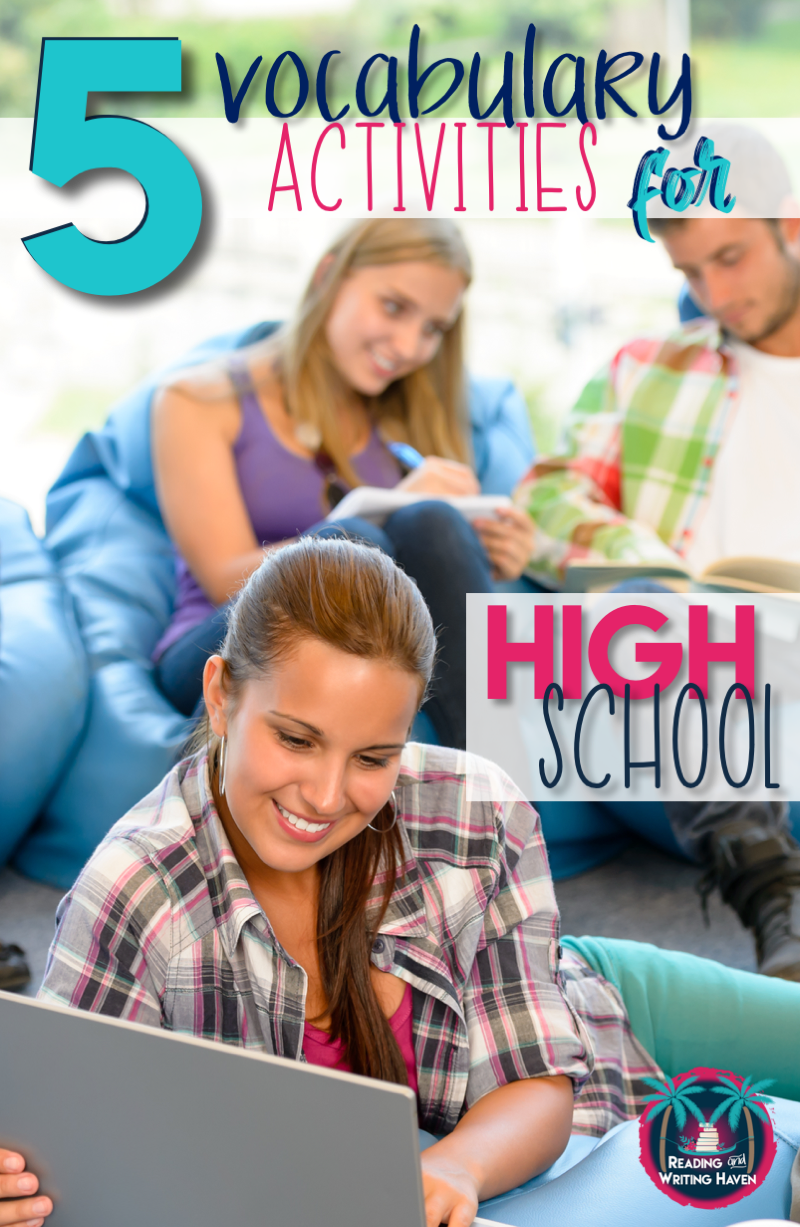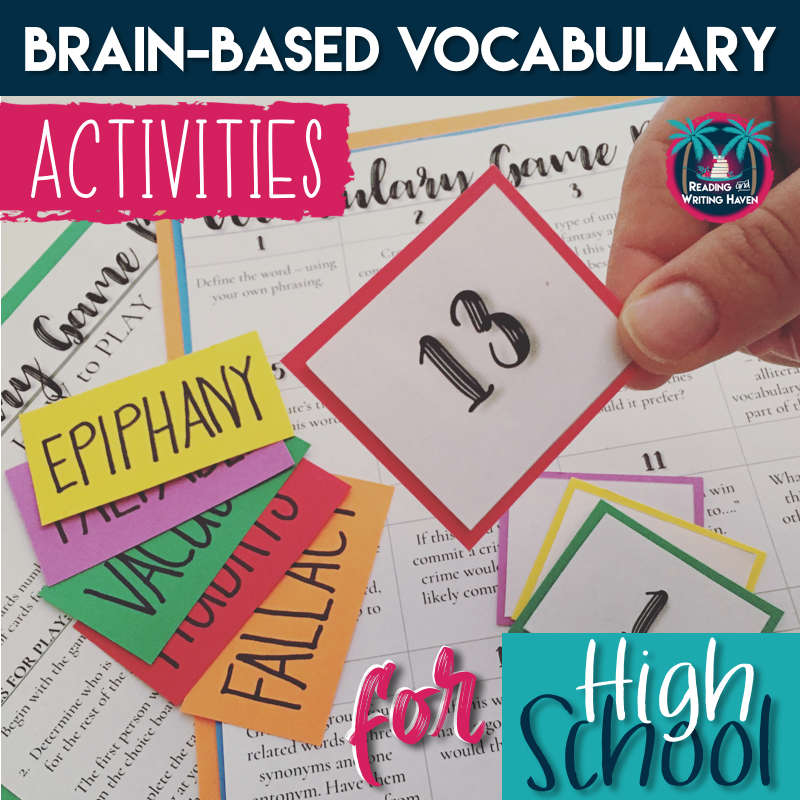5 More Vocabulary Activities for Older Students
If you want your students to learn words for the purpose of remembering them and actually using them in reading and writing, you need to make sure they engage with their vocabulary in unique and meaningful ways. If you read my first post about brain-based vocabulary in the secondary classroom and are on a quest for more vocabulary activities to add to your teaching arsenal, I’ve got them. Keep reading.
1. CONTINUUM
I like using continuums because they help students reflect on their understanding of the word, and they also give me a valuable quick check for understanding. Some of my favorite ways to use continuums are to ask questions like these:
- How well do you understand the word? (Have students place the word on the continuum, and make sure the continuum is somehow labeled…by numbers (1-10) or by words: I have never heard of this word; I’ve heard of it, but I can’t define it; I can use this word in my sleep, etcetera).
- How well do you understand the… part of speech? root word? definition? synonyms and antonyms? examples and non-examples? sentence application? Ask students to indicate their understanding of each aspect on the continuum. In order to do this activity, students must practice reflection.
- How does this word relate to ___? (Give students additional words to place on the continuum with the vocabulary word, or allow them to choose some themselves.) Place the word on the continuum next to words that are like it or far apart from words that are unlike it.
2. GALLERY
Gallery activities can work a couple different ways, but I love how they encourage students to think about new words creatively. After your students have been introduced to their word lists and have spent some time interacting with the vocabulary, assign each student a different word (or words). Make sure students don’t share what word they have been assigned (as much as possible). Then, tell students to bring in at least one item from home that relates to or symbolizes that vocabulary word (no valuables – Mom’s diamond ring and Dad’s cash stash are off limits!).
On the day students bring in the objects, display them around the room in a gallery format. You can use pictures instead of objects if you prefer. Ask students to walk around the room and take some notes regarding which words they think pair best with which objects or pictures. Then, as a class, hold a discussion. This one is always engaging and enjoyable – not to mention memorable. This activity works really well as a review of multiple vocabulary units as long as too many words are not included.
3. SKITS & FASHION SHOWS
I’ve had success when using skits with vocabulary. It’s the most beneficial as far as retaining word meanings to assign each pair of students one word. For instance, maybe one set of partners has the word abase. Their job is to work together to make a skit that revolves around this word. In doing so, they can include figurative language – metaphors, similes, personification, hyperboles, alliteration, and etcetera to deepen their understanding.
On a related note, students can also be the star of the stage if you host a vocabulary fashion show. In the elementary level, teachers sometimes hold letter fashion shows where students decorate large paper brown bags as vests. Each student is assigned a letter, and he or she creates a vest that demonstrates his or her understanding of how the letter is used. This vocabulary fashion show is the same type of concept. Students are each assigned a word, and they do their best to dress as that word. After students “walk the runway,” the class can discuss all of the ways the outfits help them understand the word. To avoid marginalizing students who don’t have access to the materials necessary to make an outfit, consider hosting a costume design party for a class period.
Both of these activities are extremely liberating for outgoing students, but they are a challenge for introverts. Consider offering an alternate choice in the event that some of your students just couldn’t bare the thought of acting or walking the runway. One possibility that still includes a presentation aspect would be to allow students to individually put together a word in a bag (or a word in a box). In doing so, they collect items that relate to the word, and they can teach the class about why those objects relate to the word when they present.
4. SPEED DATING
Anything speed dating is always engaging. Here’s how I run speed dating vocabulary in the classroom. One person (Student A) acts as the word. (In order to do this, the student who is acting as the word needs to understand it pretty well.) Another teen (Student B) sits across from the “word.” Student B asks Student A questions to try to get to know the “word” on a personal level. Example questions include:
- What makes you happy, sad, or angry?
- Which attributes are your best?
- What is your dream job?
- What did you do last weekend?
The list of possibilities is endless. After about three minutes, give students the signal to switch. You can also have the two groups switch roles halfway through the speed dating activity. I love this exercise because it makes students think about their words from an intimate level. In order to know what your dream job is if you are the word antagonize, for example, you have to understand the word to its core. The specific speed dating activity I use is included in my engaging vocabulary activities bundle.
5. BACKWARDS DESIGN
Instead of telling students the vocabulary words and providing the definitions, have students engage in critical thinking activities that lead them to the definition through inductive learning. You can do this in a variety of ways. One of my favorites is to project the words and definitions on the board in random order. Then, I ask my students to guess which word they believe goes with which definition. This discussion is always interesting because some students recognize the part of speech of certain vocabulary words even if they have never heard of the word before – which leads them to be able to make an educated guess about the definition. Other students make connections with related words or root words, which also aids them in guessing accurately.
After this initial activity, I don’t tell students if they are correct or incorrect. The next step is to provide sentences that use the word with context clues. As a class or in small groups, students discuss how their initial guesses might be right or wrong based upon how the definitions they originally selected complete the meaning of each sentence. This activity works because students are engaged in critical thinking and meaning-making instead of passively scribbling definitions from a lecture or dictionary.
Teaching vocabulary in high school is one of my passions. When students truly learn words, it empowers them to be better readers and writers. It gives them a feeling of control over their language. It enables them to speak persuasively and with emotion. Vocabulary activities can be fun. In my classroom, they are meaningful, engaging, and rewarding. If you’d like to read more about how to effectively teach vocabulary in high school, check out these posts about increasing retention of new words and extension activities for older students.
RELATED RESOURCE
This teaching resource contains three engaging vocabulary activities for high school students: a continuum with extension activities, a game, and a speed dating activity.
[sc name=”mailchimp1″]


